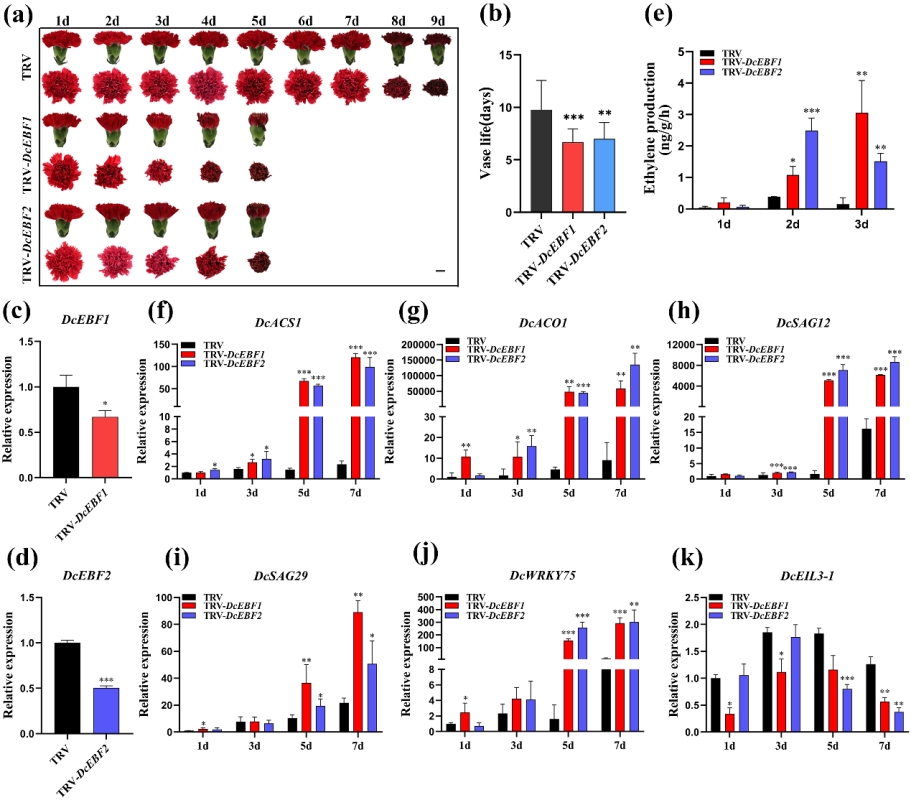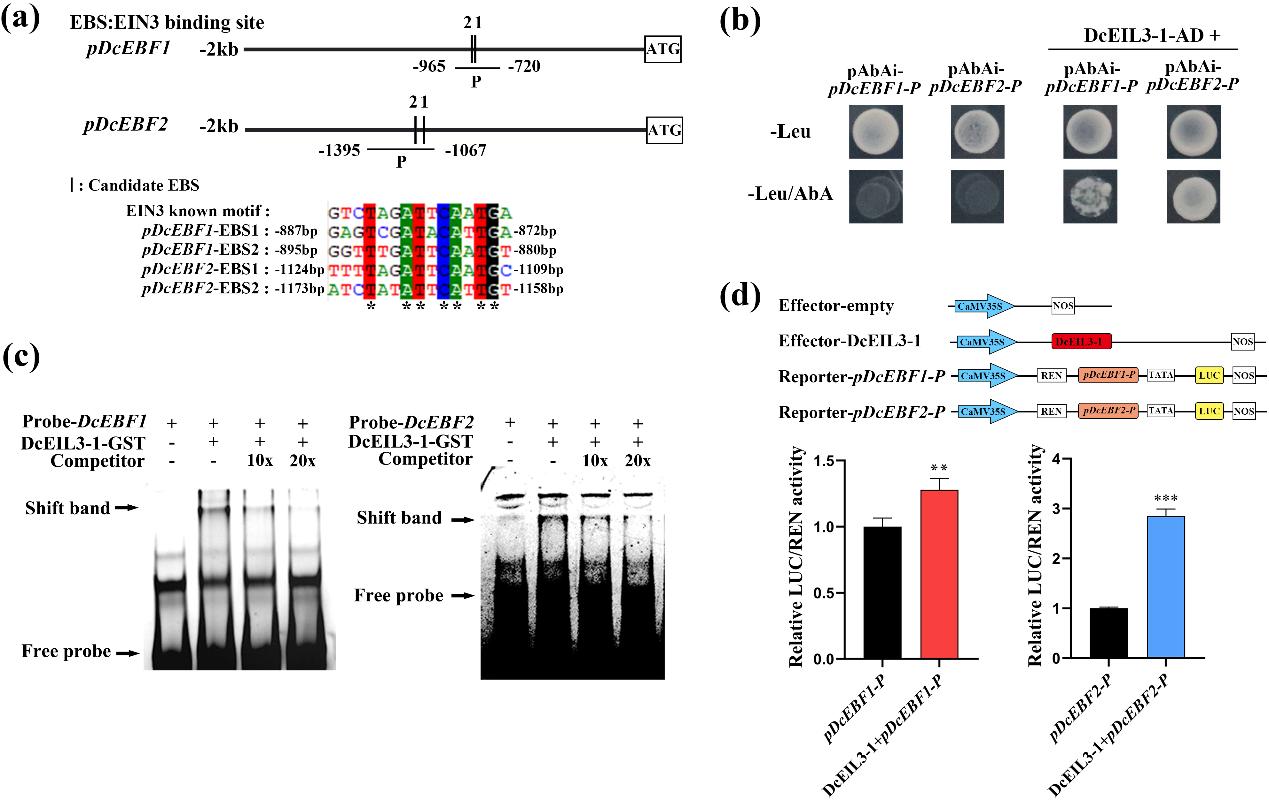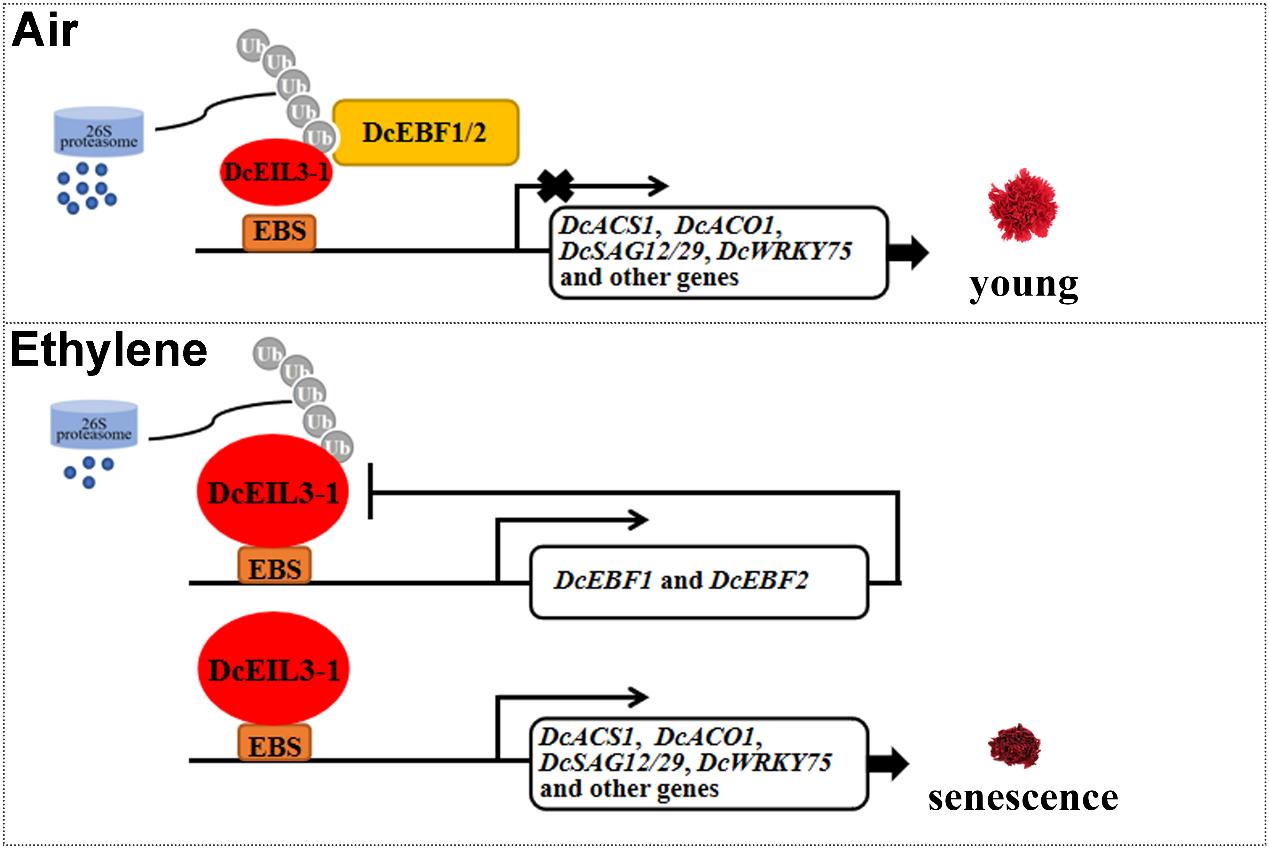南湖新闻网讯(通讯员 朱春琳)近日,我校果蔬园艺作物种质创新与利用全国重点实验室、湖北洪山实验室张帆教授课题组通过组学和分子生物学实验揭示了泛素化修饰调控康乃馨鲜切花采后衰老的分子机理,拓展了人们对康乃馨鲜切花采后衰老分子机制的认识,为培育货架期和瓶插期延长的康乃馨新品种奠定了关键的理论基础并提供了重要的基因资源。该研究以“The mutual regulation between DcEBF1/2 and DcEIL3-1 is involved in ethylene induced petal senescence in carnation (Dianthus caryophyllus L.)”为题发表在Plant Journal上。
花卉是极其重要的园艺作物,在满足人们的精神需求,服务乡村振兴和美丽中国建设中发挥着越来越关键的作用。康乃馨(Carnation)学名香石竹(Dianthus caryophyllus L.),是世界四大鲜切花之一,具有极高的观赏价值和经济价值。康乃馨同时也是一种典型的乙烯敏感性切花,被认为是研究乙烯调控鲜切花采后衰老,特别是花瓣衰老的模式植物。张帆教授课题组前期研究系统揭示了乙烯信号通路核心转录因子DcEIL3-1通过下游组分调控康乃馨花瓣衰老的分子网络(王妍等, 园艺学报, 2022; Xu et al, Plant Journal, 2021; Xu et al, Journal of Experimental Botany, 2022; Wang et al, Plant Journal, 2023),近期研究也阐明了表观遗传修饰调控康乃馨花瓣衰老的分子机制(Feng et al, Plant Physiology, 2023),但对于乙烯信号通路核心转录因子DcEIL3-1本身的调控机制仍不清楚。
为了分析乙烯如何调控DcEIL3-1,本研究对课题组前期构建的乙烯处理不同时间的康乃馨花瓣衰老进程转录组数据进行分析后发现,两个E3泛素连接酶DcEBF1和DcEBF2在康乃馨花瓣衰老过程中能够快速响应乙烯并显著诱导表达。通过VIGS技术瞬时沉默DcEBF1和DcEBF2能够明显加速康乃馨花瓣的衰老进程,同时DcEIL3-1下游靶基因的表达量明显上升,而DcEIL3-1本身的表达量却显著下降(图1),暗示DcEBF1和DcEBF2可能在翻译后水平上调控DcEIL3-1的表达。

图1. 沉默DcEBF1和DcEBF2能够明显加速康乃馨花瓣的衰老进程
进一步的研究发现,DcEBF1和DcEBF2 能够与DcEIL3-1发生相互作用并泛素化降解DcEIL3-1(图2)。

图2. DcEBF1和DcEBF2 能够泛素化修饰DcEIL3-1
进一步的分子实验表明,DcEIL3-1能够结合到DcEBF1和DcEBF2的启动子上并激活它们的表达(图3),这说明DcEBF1和DcEBF2与DcEIL3-1之间存在正负反馈的交互作用。

图3. DcEIL3-1能够结合并激活DcEBF1和DcEBF2的启动子
本研究阐明了DcEBF1和DcEBF2与DcEIL3-1交互作用共同调控乙烯诱导的康乃馨花瓣衰老的分子机制(图4),进一步拓展了人们对康乃馨花瓣衰老分子调控网络的认识。这为培育货架期和瓶插期延长的康乃馨新品种奠定了关键的理论基础并提供了重要的基因资源,同时对其它观赏花卉和鲜切花的采后保鲜也具有重要的理论价值和实践意义。

图4. DcEBF1/2与DcEIL3-1交互作用共同调控乙烯诱导的康乃馨花瓣衰老的工作模型
华中农业大学果蔬园艺作物种质创新与利用全国重点实验室博士研究生朱春琳和出站博士后黄志恒为论文共同第一作者,张帆教授为论文通讯作者,程运江教授和包满珠教授参与了本研究。本研究得到了中央高校基本科研业务费专项基金(2662019PY049)和华中农业大学高层次人才启动经费项目等的资助。
审核人:张帆
【英文摘要】
Carnation (Dianthus caryophyllus L.) is a respiratory climacteric flower, which is one of the most important cut flowers extremely sensitive to plant hormone ethylene. Ethylene signaling core transcription factor DcEIL3-1 plays a key role in ethylene induced petal senescence in carnation. However, how dose DcEIL3-1 be regulated in carnation petal senescence process is still not clear. Here, we screened out two EBF (EIN3 Binding F-box) genes, DcEBF1 and DcEBF2, which showed quickly elevation by ethylene treatment according to the ethylene induced carnation petal senescence transcriptome. Silencing of DcEBF1 and DcEBF2 accelerated while overexpression of DcEBF1 and DcEBF2 delayed ethylene induced petal senescence in carnation through influencing DcEIL3-1 downstream target genes but not DcEIL3-1 itself. Further, DcEBF1 and DcEBF2 interact with DcEIL3-1 to degrade DcEIL3-1 through ubiquitination pathway in vitro and in vivo. Last but not least, DcEIL3-1 binds to the promoter regions of DcEBF1 and DcEBF2 to activate their expression. In conclusion, this study revealed the mutual regulation between DcEBF1/2 and DcEIL3-1 during ethylene induced petal senescence in carnation, which not only expanding our understanding about ethylene signal regulation network in carnation petal senescence process but also provide potential targets to breed cultivar of long-lived cut carnation.
论文链接:https://onlinelibrary.wiley.com/doi/10.1111/tpj.16158